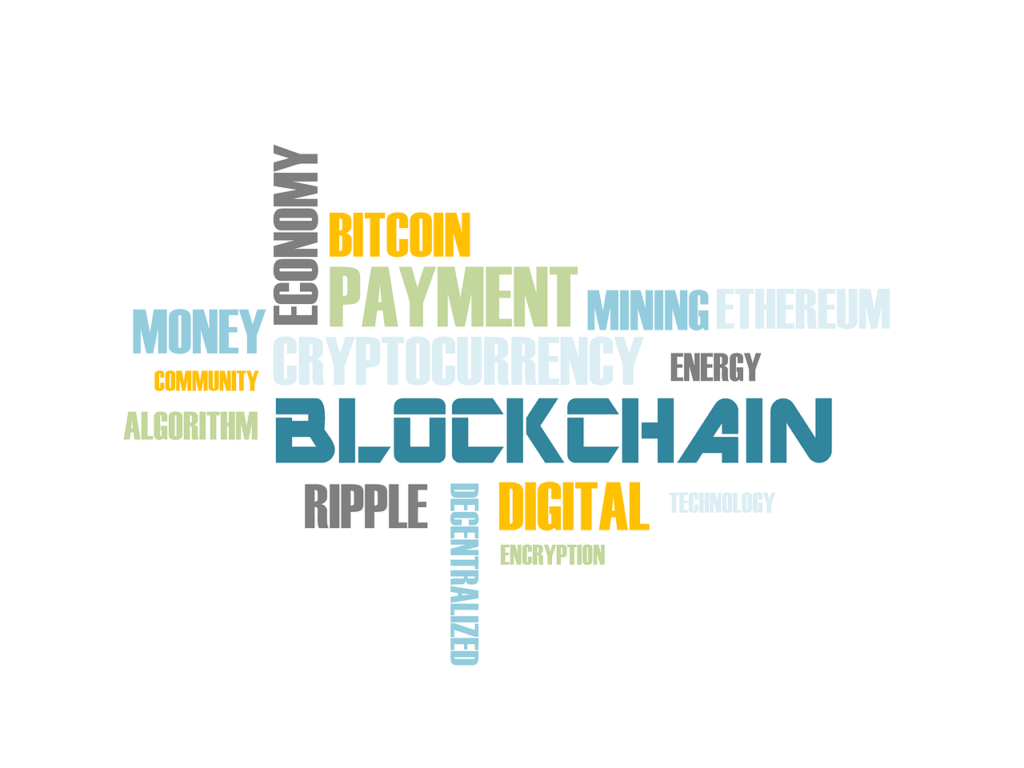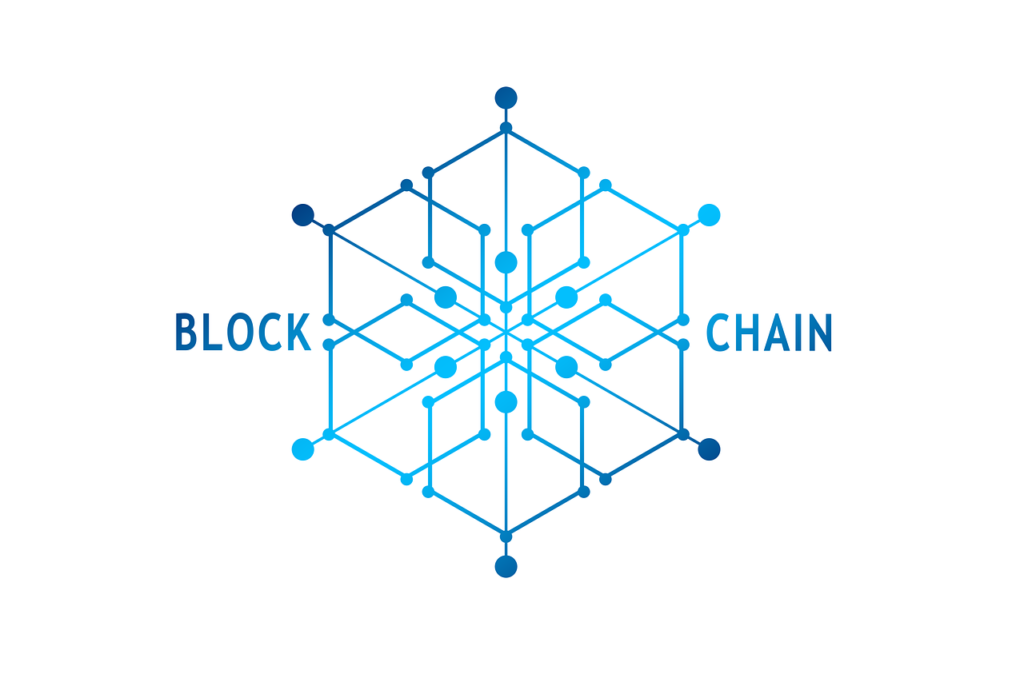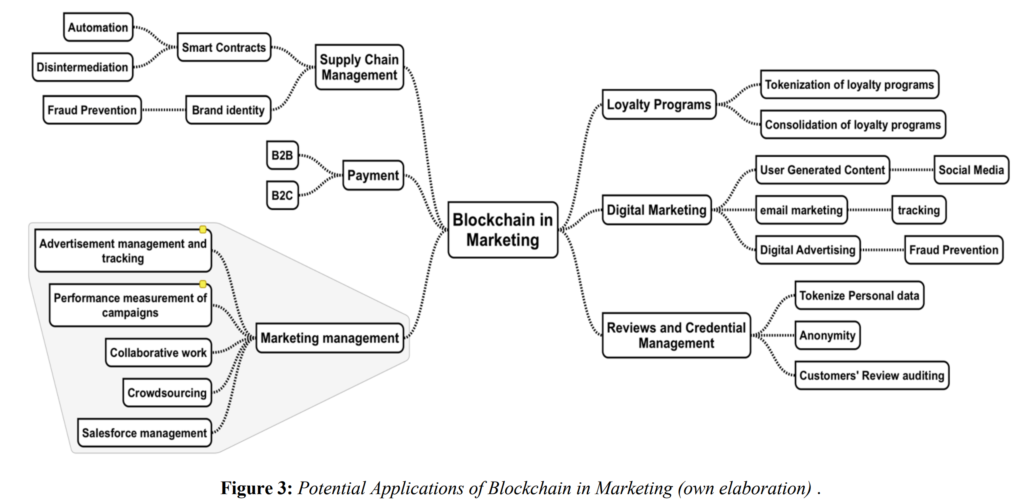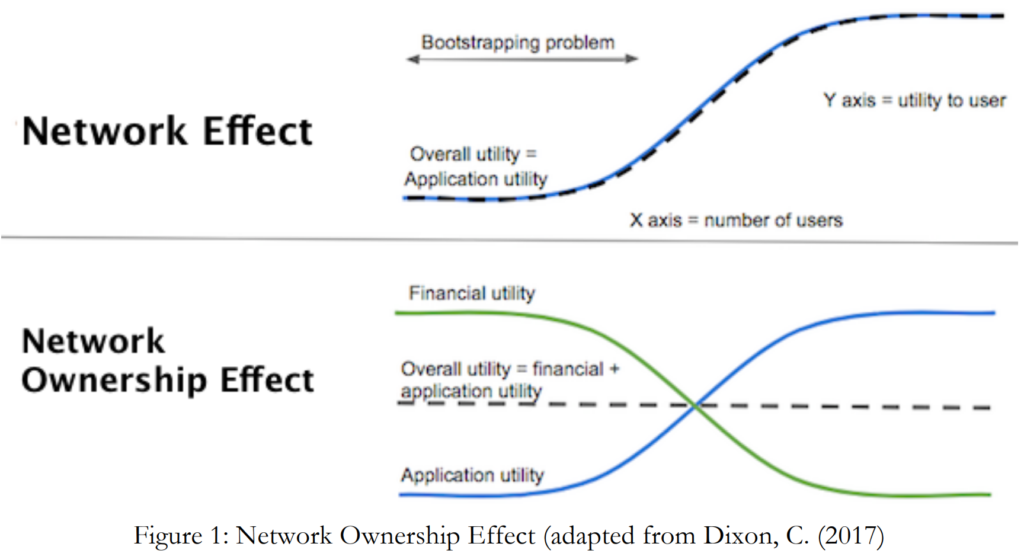Thanks to Bitcoin and other Cryptocurrencies, Blockchain has become widespread and popular. Besides Finance, it is also transforming the Supply Chain. But this technology may also be a game changer in other functional areas. Has Blockchain the potential to influence Marketing in the future as much as it does with Finance today ?
Here is an exploration of the Blockchain Technology foreseeable impact and disruption on Marketing and Customer Relationship. It includes Academical research references, Business Use Cases and a bit of imagination. For a functional explanation of the Blockchain Technology, refer to this page. For a technical overview, check this one. Either it is called Blockchain, Distributed Ledger Technology or DLT, it refers to the same technology.
“The adoption of blockchain can lead to further and more radical disruption in the ways that we are communicating with consumers, and the way that we manage marketing mix and marketing programs redefining the meaning and importance of holistic marketing.” (Antoniadis et al, see bibliography below).

Picture by Tumisu on Pixabay
Why Blockchain is a game changer for marketing
Immutability and Reliability
From its decentralized nature, the information within the Distributed Ledger Technology is invariable and always available as it is copied in multiple locations (the nodes of the Blockchain). These functionalities are the necessary foundation for other characteristics such as Transparency and Trust Building (see below).
Decentralization and disintermediation
A critical value of Blockchain is that it can remove Trusted Third Parties and still ensure a high level of trust and transparency. “Blockchain’s decentralized nature comes from its peer-to-peer network structure coupled with cryptographically secured technology and consensus driven mechanism […] This enables Blockchain eliminate the need to all kinds of intermediaries“ (Ertemel, see bibliography below).
Similarly to Cryptocurrencies getting rid of Central banks, this Technology may threaten GAFAM Oligopolistic positions, particularly Google, Facebook and Amazon. Such Third Parties use their relative level of trust to monetize Consumers’ Personal Data, but how long will it last if an alternative exists?
Privacy and Data protection
Blockchain information is encrypted. So potentially, the technology allows consumers to take back control on their data instead of leaving them to unsecured databases from which they are regularly stolen. “They [the consumers] even may decide to accept payments (and/or other incentives) to disclose data (or make it algorithmically available but with anonymity) to companies for advertising or for personalisation purposes.”(Bezovski et al, see bibliography below)

As an example, https://brave.com/ is a Blockchain-based browser which protects its users’ privacy and rewards them using a cryptocurrency named Basic Attention Token (BAT). The cryptographic dimension of Blockchain combined with a near-zero transaction cost allows Consumers monetize their data and choose which Brands to interact with. Additionally to a source of revenue for Consumers, it is becoming an empowerment of their values.
Transparency
From SPAM, Marketing Fraud, Fake Customer reviews to Fake Accounts, Blockchain has the power to increase transparency in the digital media. Although it may look contradictory, Cryptographic Blockchain offers its users both anonymity and identity validation. “Pseudonimity allows users to remain anonymous to the other parties in conducting transactions while providing their proof of identity on the protocol level.” (Ertemel)
“Blockchain will also make it difficult for bots to set up fake social media accounts, flood users with deceptive messages, and steal online advertising dollars from big brands” (Harvey et al, see bibliography below). A lot of projects are working at bringing pseudonymity to reality through Blockchain, such as https://www.adex.network/ and https://www.serto.id/.

Programmability and automation
Distributed Ledger Technology can encapsulate, not only value, assets and information, but also programs and algorithms called Smart Contracts or Decentralized Apps (dApps). This is probably the most promising dimension of Blockchain. Ethereum https://ethereum.org/, Polkadot https://polkadot.network/ and Solana https://solana.com/ are among many organisations active in smart contracts, with innovative concepts such as Decentralized Autonomous Organizations (https://ethereum.org/en/dao/). The potential is vast and still difficult to envision.
Trust Enablement
“Coupled with the other attributes, Blockchain’s foremost characteristic is its trust-enabling nature” (Ertemel). As a summary of the above, Blockchain Technology intrinsically enables trust within a system, throughout a community, between brands, companies, users and consumers.
Risks of Blockchain and potential mitigation
Hacking
Whereas Blockchain is perceived as highly secure (Bitcoin exemplifies it every day), there are risks however. The main hacking risk involves Smart Contracts which are basically programs. As programs are written by humans (such as contracts, by the way), risks of error and breaches are always possible. History of Ethereum has proved so: the DAO Hack is famous and largely discussed, as an example of a smart contract breach which was exploited by one of its users in June 2016. It could be resolved but changed Ethereum for good.
Another possible hack, named the 51% hack, only involves smaller scale blockchains as it require the hacker to own 51% of its assets. As a consequence, the hacker can decide anything, rule and steel the rest of the community.
Carbon footprint
Also largely discussed, the Carbon Footprint of Bitcoin Mining is definitely affecting Global Warming. The solution is to switch the Consensus Mechanism (the transaction verification and authentication process) from proof of work to proof of stake. To summarize, validation of blocks (i.e. security) would no longer be based on calculation power as for mining but on some kind of a “voting” power from the community. Again, the staking system needs to be set up cautiously. Ethereum is considering to move to Proof of Stake. Other Blockchains Ecosystems and Cryptocurrencies already use Proof of Stake: Polkadot, Cardano, Cosmos, among others.

Scalability and Interoperability
Often stated by experts as technical limits for Distributed Ledger Technology, Scalability and Interoperability mainly concern early generations of Blockchains, such as Bitcoin and Ethereum.
Scalability issues happen when the number of transactions exceeds the network capacity so that it causes delay in completing transactions. There are technical workarounds but the main solution for first and second generation Blockchains is to update itself through a Hard fork that is to say an update of the code itself.
Interoperability means that Blockchains cannot communicate with each other. This is the case for Bitcoin (first generation) and Ethereum (Second generation). The solution is to use Third generation ones as a hub. Cosmos can do this. Blockchains built with the same SDK (Software Development Kit) are interoperable and compatible with Cross-Chain communication.
Such technical limits have been resolved by the latest generation of Blockchains which are technically more advanced, e.g. Polkadot (DOT) and Cosmos (ATOM).
Current Blockchain Strategies
Public Blockchain or Private Blockchain
The difference is in the control and the transaction verification process . “A public blockchain network is completely open, and anyone can join and participate in the network. A private blockchain network requires an invitation and must be validated by either the network starter or by a set of rules put in place by the network starter,” declares Praveen Jayachandran, a blockchain researcher from IBM. Bitcoin is an example of a public Blockchain.
A brand would probably want to set up a private Blockchain so that it would be able to control it. For example, if a brand is planning to set up a Blockchain as a loyalty System (see use case below) in order to reward its customers for their contributions to the brand, it might be a private blockchain dedicated to the brand’s customers. But the brand may also be willing to leave the door opened to non-customers or enable interoperability of its cryptocurrency with other Blockchain Systems or Hubs.

Consortium Blockchain
The Consortium Blockchain is between Public and Private Blockchain as it is controlled by a group of organizations. There are several examples of industry-specific vertical consortiums such as the MOBI, the Mobility Open Blockchain Initiative in the automotive industry, the Marco Polo Network for the Financial Services, the BITA in the Supply Chain and AdLedger in digital media. These consortiums can be exploring specific applications or breakthrough usage for the Blockchain in their respective industries. They are also useful for building entry barriers, share risks and keep an eye on competitors. The supposedly disintermediation benefit of Blockchain may seem to generate new middlemen but this is mainly a way to manage uncertainty.
Another interesting Consortium is taking place in Spain: Alastria. This consortium has been initially set up with National, cross-industry and non-profit scope. Such initiative has potential for Blockchain innovation as it may disclose cross-industry innovative usage and expand Blockchain interoperability. After almost 4 years since its announcement, whereas it definitely had an impact in progressing awareness and legislation, Alastria has not yet produced decisive developments.
Blockchain Applications in marketing
Blockchain impact on marketing may not be as obvious as in Finance, Supply Chain, Insurance or Health. It will transform marketing and may be more disruptive and sooner than expected.
Zlatko Bezovski, Tamara Jovanov Apasieva and Riste Temjanovski are listing in their article “The Impact and the Potential Disruption of the Blockchain Technology on Marketing” the following fields:
- Digital Identity (digital ID, self-sovereign identity, secure ownership of data)
- New products and services (Decentralized apps)
- Supply Chain Management (replacing current systems)
- Customer Relationship Management (replacing current systems)
- Loyalty Programs (multiple brands involvement, single loyalty wallet, tokenized reward points instead of coupons, exchange of selling reward points)
- Advertisement and click fraud (fighting click fraud, targeting while preserving privacy, cost efficient advertising, trusted affiliate partnerships)
Moreover, Antoniadis I., Kontsas S. and Spinthiropoulos K. are summarizing, in their article “Blockchain Applications in Marketing” various dimensions of Blockchain impact on marketing in the following figure:

Use Cases
Blockchain Transformation in the digital media industry
Platforms have never been so strong: nowadays, Google, Facebook and Amazon are getting most of Digital Media revenues worldwide and nothing seems to threaten this Oligopoly. Nevertheless, there are weak signals that this may change, nobody knows how and when but disruption is on its way.
As previously described, a lot of initiatives involving Blockchain Technology are taking place, such as https://brave.com/ , https://www.adex.network/ and the Consortium https://www.adledger.org/ There is also https://reftoken.io, a decentralized affiliate platform.
Larger organizations, such as www.mediaocean.com, a major adtech firm, are engaging into Blockchain. After partnering with IBM to set up the technology, Mediaocean has implemented it into its Digital Ad Management system, thus reducing drastically intermediation.
https://decrypt.co/, a digital media publisher specializing in Cryptocurrencies and Blockchain has uncovered an interesting initiative aiming at driving Media Decentralization through the building of a Media DAO (Decentralized Autonomous Organization) using a cryptocurrency, the reader rewards token.
The Network Ownership Effect: a Business Model for Start-up companies
“Blockchain technology has the potential to democratize starting a new business by coining a new concept, network ownership effects also known as token network effects (Dixon, 2017) […] Participants who need to own project tokens also gain by the increase in token price. When project is in its infancy, those who believe in the project’s story are inclined to buy its tokens while the price is cheap. As they own more tokens, they evangelize the project to others. As such, in the beginning ownership of the network by participants is the key driver for the network to gain momentum” (Ertemel).
This Business Model empowers and rewards early adopters, builds a community as a foundation for a growing start-up business (refer to Ertemel article). https://steemit.com/ , a Blockchain-based blogging and social media website, built following this model, was recently acquired, which may suggest the fragility of this model. Another example, the Israeli La’Zooz (Uber and BlablaCar competitor) is no longer active. Although it still misses a successful Use Case, this Business Model seems very much valid for the sharing economy.

Blockchain as a Loyalty System
Such Use Cases are still limited in scope and timeframe. American Express launched in 2018 a blockchain test with Boxed allowing the online wholesale retailer to customize rewards for cardholders. Singapore Airlines operates and maintains a Blockchain Loyalty System: krisplus, a digital miles reward wallet using blockchain. Cathay Pacific Group also leverages Blockchain Technology in Asia Miles, its loyalty system. Additionally, Digitalbits (XDB) is a Cryptocurrency “used to power consumer digital assets”. It should enable loyalty points exchange between brands.
Blockchain Technology seems to fit ideally the concept of Customer Lifetime Value: imagine a brand which uncovers the set of rules used to calculate Customer Lifetime Value. Imagine that this brand decides to actually reward its customers accordingly, granting X coins for a positive review in specified social media, Y coins for a referral, Z coins for published content, etc
Distributed Ledger Technology offers brands a comprehensive system to track and reward all interactions with their Customers, wherever they take place, digitally (Social Media, emails, …) or physically (shops,…), whoever they interact with (influencers, non-customers, the Brand, …) and whatever the nature of these interactions (review, like, referral, …).
Established brands are still reluctant to implement Blockchain for several reasons. It is probably a matter of time and technology maturity. But, sooner or later, major brands should be launching more comprehensive Blockchain-based loyalty programs with a dedicated (or shared) cryptocurrency to reward their customers for their actions in favour of the brand.
Conclusion
Blockchain technology will certainly disrupt Marketing and the Relationship between brands and consumers. Both brands and consumers will benefit from it. Consumers will get increasing Data Protection, empowerment and potentially revenue. Brands should leverage Blockchain’s automation, disintermediation, transparency and trust building capabilities. But this is only the tip of the iceberg. The disruption of Blockchain may go a lot further, to some extent that are yet difficult to imagine. Whatever Blockchain has to offer in the future, it is time for brands to explore its potential.
Bibliography
- Antoniadis I., Kontsas S., Spinthiropoulos K, Blockchain Applications in Marketing (July 2019), https://www.researchgate.net/profile/Ioannis-Antoniadis/publication/337439697_Blockchain_Applications_in_Marketing/links/5dd78fc0458515dc2f41fffe/Blockchain-Applications-in-Marketing.pdf
- Bezovski Zlatko, Jovanov Apasieva Tamara, Temjanovski Riste, The Impact and the Potential Disruption of the Blockchain Technology on Marketing (2021), http://eprints.ugd.edu.mk/27860/2/4190-Article%20Text-6938-1-10-20210224.pdf
- Dixon, C., 2017, Crypto Tokens: A Breakthrough in Open Network Design https://medium.com/@cdixon/cryptotokens-a-breakthrough-in-open-network-design-e600975be2ef
- Ertemel, Adnan Veysel, Implications of Blockchain Technology on Marketing (March 12, 2019). Journal of International Trade, Logistics and Law, Vol. 4, Num. 2, 2018, 35-44, Available at SSRN: https://ssrn.com/abstract=3351196
- Harvey Campbell R., Moorman Christine, Toledo Marc, How Blockchain Will Change Marketing as We Know It (September 29, 2018), http://mx.nthu.edu.tw/~cshwang/data-economics/course-infoecon/INFE07-Blockchain/Harvey=Blockchain%20Changes%20Marketing-2019.pdf
- Pazaitis, A., De Filippi, P., & Kostakis, V. (2017). Blockchain and value systems in the sharing economy: The illustrative case of Backfeed. Technological Forecasting and Social Change, 125, 105-115.
I’m impressed, I must say. Rarely do I encounter a blog that’s both equally educative and entertaining, and without a doubt, you have hit the nail on the head. The problem is something which not enough people are speaking intelligently about. I am very happy I stumbled across this during my search for something relating to this.
I’m not sure where you’re getting your information, but good topic. I needs to spend some time learning more or understanding more.
Thanks for wonderful information I was looking for this information for my mission.